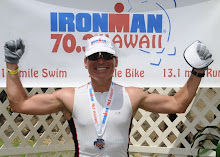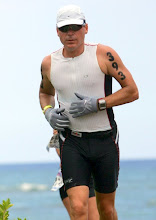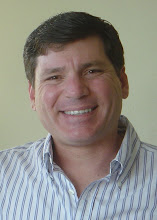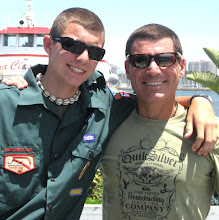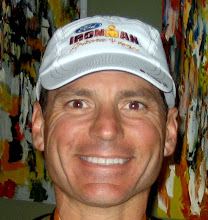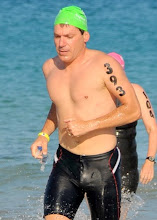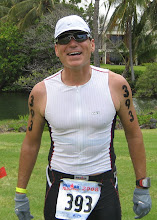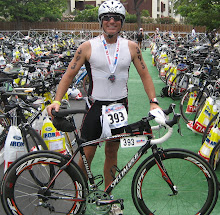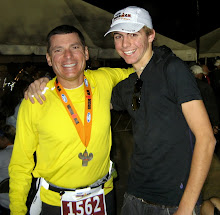
My wife started this magnetic support system in my Ironman kitchen (yep, our full prep kitchen has been converted and is now set up entirely for powders, potions, GU, gels, nutritional supplements, shake makers, Gatorade G2, etc. The kitchen also has a dishwasher customized to handle all the plastic bike bottles and hydration systems so that none of the caps slip through the grates and get melted in the drying cycle! Of course, the most important part of the kitchen is the Nespresso machine which I absolutely swear by, love and am the world's biggest proponent...they are brilliantly designed and absolutely trouble free for the perfect Espresso with no hassle whatsoever. http://www.nespresso.com/)
The magnetic sign was important because every day I walk by the back prep kitchen on the way to and from the garage, I would see those words of encouragement. My wife had found and arranged those letters to get that sign started and I could feel her support every day.
The importance of a support network cannot be overstated.
The pursuit of the Ironman dream can take an incredible toll not just on the athlete, but also on his or her family, friends and work associates.
I often think of this pursuit as a very selfish endeavor. The time commitment away from one's family is enormous.
Five to Eight-hour workouts on the weekends are now the norm. Plus the time to prepare the bike, nutrition, the actual plan of where I am going, then to upload all the power data, HR data, etc. can take an additional 1 - 2 hours.
Naturally, once the data is input, the research and analytical side kicks-in and I want to study how I did, if I am improving, etc.
My wife has fluctuated from being: amazed, amused, accepting, supportive and understanding. Connor has been terrific and it feels great to have a 15-year old son who is so proud that his Dad is accomplishing these endurance events. There have been many, many times when I have just been way too tired for various workouts, only to have my wife rib me, pressure me or use some kind of reverse-psychology to get me out the door.
Sometimes she'll say, "Yeah, don't work out. You don't need to. You know you are ready." Which of course is effective sarcasm that gets me out the door pronto! Other times she'll say, "Go on. Come on, just get out there and get going." Somehow, she can read me well enough to know which buttons to push.
Connor saved me the night before my first 70.3 in Hawaii. I will never forget it.
I was up at 3:00am pacing the hotel room. I was most worried about the swim. Connor just sensed that I was worried and he got up and came to me and gave me a huge hug (he's now taller than me!) and he said, "Don't worry Dad. You've got this. You've got it!"
Having my son support me like that was priceless.
Another support mechanism is my coach, David Warden. David is one of the world's leading experts on the science behind Triathlon and the world's most effective training methods. He only works with seven people, so I am extremely lucky and grateful to have him on my team! There is this subtle self-created pressure that I do not want to let David down, and I do not want to report that I did not complete all my workouts as scheduled. Knowing that David reviews every workout and all my power and HR data, is enough to get out the door on some days.
My business partner Kevin has been incredibly supportive. I am either arriving late or leaving early, especially during daylight savings time. The extra work often falls onto him, and he never complains. He is also the voice of reason when I tell him how close I was to coming to blows with a crazy driver or a wheel sucker.
When pursuing the Ironman dream, many people must pull together to support you, especially if you are married, have a family or are working full time. The time to get everything done has to come at the expense of something. It's as simple as that. Where do you find an extra 15 - 20 hours a week? You surely cannot cut back on your sleep, as when you are working out this much, you must have the sleep for your body to repair and rebuild.
The time for these workouts comes at the expense of relationships, work, keeping up the house, other hobbies, television or other past times, etc. In my case, the time has come from work, from the elimination of essentially all TV, and in keeping up on things in general.
The pursuit requires one to be exceptionally-well organized and to have systems in place to ensure that things don't start slipping through the cracks, because believe me, they will if you are not careful! That's where your support network can really come in and help.
This pursuit can stress work, family and outside friendships. If your critical relationships are not solid and in good standing prior to starting your Ironman training, I would suggest that you really shore-up those relationships and have a candid discussion about the toll your training will likely take on others.
The toll?
- You will be going to bed a lot earlier (I go to bed at 9:00pm; it used to be midnight).
- You will be cranky and possibly short-tempered, especially during your long weeks.
- If you have a short temper before you start this endeavor, it could be magnified by your training.
- You will be sore a lot of the time. You will likely complain about it. At first you will get sympathy, but that won't last long. Too much complaining can begin to grate on people.
- You will likely be going to see the doctor more frequently, and usually to some sort of specialist. I have been to see doctors more in the past 12-months than in the past 20 years combined. (Broken ankle, hip problems that required four visits to an orthopeadic surgeon for x-rays an MRI and evaluations totally over $7,000, knee problems that required thousands of dollars of additional x-rays and evaluations, hernia, IT band problems, knotted up trigger points called 'myofascial pain syndrome' in my upper trapezoid area from the crouched aero position on my TT bike, black toenails, toenails falling off, massively-huge and very deep blisters, a year-long plantar wart problem that required Podiatrist action, plantar fasciitis, hemorrhoids (from bike?), pre-cancerous growths from sun exposure, etc)
- You will be tired and may not be as fun to be around at times.
- You will be pre-occupied and not always "present" or able to give your full and complete attention to your spouse, children, work associates and friends.
- You will definitely be spending a lot of money on equipment, a coach, bikes, travel, race fees, nutritional supplements, bike repairs, race uniforms, books, power meters, HR monitors, body fat scale, GPS watch, an Endless Pool perhaps!, gym fees, association dues, equipment bags, wetsuit, aero helmet, road helmet, custom bike fitting (a must!), race day souvenirs and the list goes on and on. When you spend this much money, one can't really get on a spouse about their spending habits...even if they already have 137 pairs of shoes!
- The list goes on...
So I find that support is very important. Sure I could still finish the full IM without this support because I am just so determined to do so. But I know for an absolute fact that I will finish healthier, faster and happier, knowing that I have so many people who love me and who are pulling for me and have supported me throughout this incredible journey!









